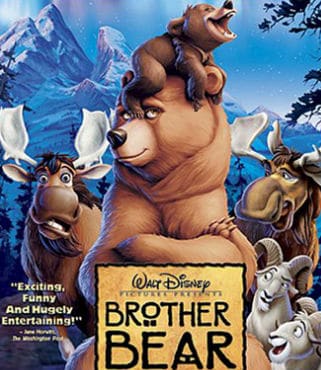
Welcome to Revisiting Disney! This week, we’re looking at a Disney movie that makes me cry every darn time, Brother Bear! Like always, I have labeled each category so if you want to skip to the parts that interest you most, feel free. And, of course, if you have any thoughts, burning or otherwise, please share in the comments!
BACKGROUND OF BROTHER BEAR
Brother Bear was released on October 24th, 2003, and it didn’t do terribly at the box office. It wasn’t The Lion King, but it was nominated for the 2004 Academy Award for Best Animated Feature. The direction team was made up of Disney Veterans Aaron Blaise and Robert Walker. Blaise had previously worked as an animator on The Rescuers Down Under, Beauty and the Beast, Aladdin, The Lion King, Pocahontas, and Mulan. Walker had previously worked on The Rescuers Down Under, Beauty and the Beast, Aladdin, The Lion King, Mulan, and Lilo & Stitch. The two are currently set to direct what is described on IMDB as Untitled Disney Animation Project, set for 2020 (Get excited!).
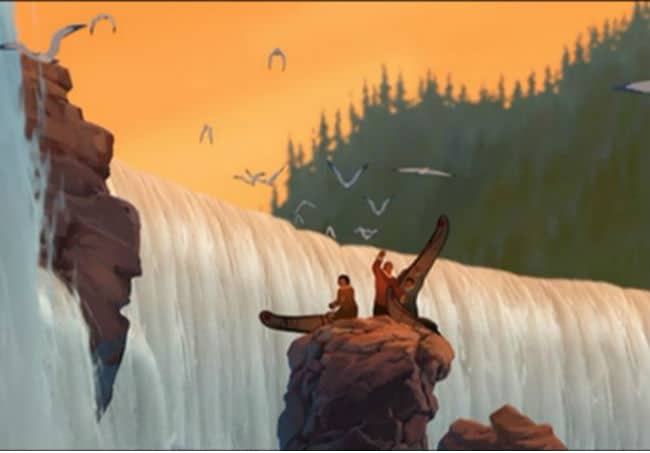
Photo: Disney
Personally, and I might have said this before, I think that the seven films made between 1999 and 2003, (Fantasia 2000, Dinosaur, The Emperor’s New Groove, Atlantis: The Lost Empire, Lilo & Stitch, Treasure Planet and Brother Bear), are really not given enough credit. I think of them as “The Experimental Early 2000’s,” and if Disney had asked my opinion, I probably would have stretched out the Renaissance to include them.
The Disney Renaissance, you see, “officially” ends with Tarzan. I would argue that there were some really creative things, artistically and technologically, coming out of the Studio during the early 2000’s, and people seemed to like the films, overall (and there was some critical appreciation too). If you’re wondering why I haven’t included Home on the Range in this time frame, and instead ended my era in 2003, we’ll get to that film (and Chicken Little), next time.
MUSIC
In Brother Bear, Disney continued the trend of not having the characters sing the majority of the songs. This works out really well, I think. The opening number, “Great Spirits,” is performed by Tina Turner, and it’s exactly the kind of song I expect from the woman who brought us “Proud Mary.” “Transformation” was performed by the Bulgarian Women’s Choir in Inuit. It was translated by a native speaker, and the song captures the haunting and magical quality that the moment calls for. Goosebumps. It’s so good.
Most of the other songs are performed by Phil Collins, although Jeremy Suarez, who plays Koda, sings part of “On My Way.” In the same way that he performed the music in Tarzan, using Phil Collins as a singer over the film allows the story to maintain a feeling of realness. I realize that I’m talking about realism in a film where a boy is turned into a bear to learn about love, forgiveness, and the bonds of brotherhood, but tomayto tomahto.
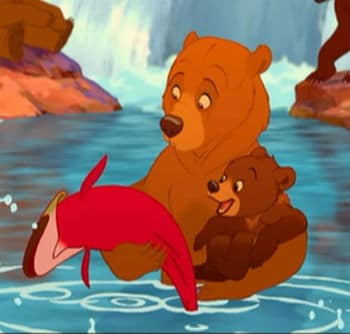
Photo: Disney
Phil Collins also wrote the songs for Brother Bear, and he was excited to be a part of another Disney film. In the “Making Of” feature, he jokes that he was a bit nervous because he had to replicate the success of Tarzan while still keeping it fresh and new. The fact that Brother Bear was an original story meant that the story was changing often. The “fishing song,” or “Welcome to the Family,” was originally more of a “bear frat party song,” that then got changed to make the bears nobler. The Blind Boys of Alabama actually sang most of this song, aiming to give it a more soulful quality.
Since the music was written as the story was written, there were a couple of other songs that were turned on their heads. Phil Collins and Mark Mancina, who had written the score for Tarzan, collaborated on the score for Brother Bear. Collins, who had never written a score before, was excited to learn and the end result is wonderful. The score builds at just the right times and knows when to lead the audience to a more somber feeling.
The score was written to incorporate bits of the Native American cultures of the Northwest at the end of the Ice Age. The music team wanted to include more of what they called “world music,” though they utilized a ton of percussion and tried to use Native American instruments often, including Hopi drums.
ANIMATION
Brother Bear was produced at Disney’s animation studio in Florida, like Mulan and Lilo & Stitch before it. However, this was the last animated film that was completed there, as the Studio decided to shut it down in 2004 when CGI films became much more popular than the hand-drawn ones.
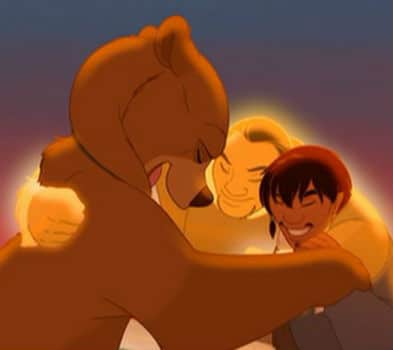
Photo: Disney
The clothing and build of each character were done deliberately. Koda was designed to move and bounce around like a five-year-old kid, while Kenai’s design even as a human was chosen because of the similarities he shared with a bear (his coat, collar, leg length, and hair style, in particular, were mentioned by his animator). For Sitka, the oldest brother, the animators wanted to make sure it was obvious that he was the oldest and the leader. This comes out in the animation of the three brothers together.
Animated in traditional 2D hand-drawn animation, Brother Bear is a gorgeous film. The backgrounds are styled in such a way as to look like paintings and are specifically inspired by the landscape paintings of Albert Bierstadt. The art team describes it as painted naturalism, and Producer Chuck Williams says that he felt that the art team was able to capture the rough and raw look of the area that the story was set in.
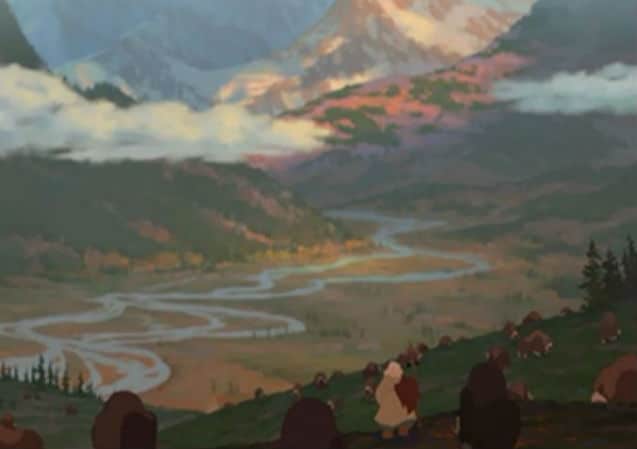
Photo: Disney
The backgrounds are the types of paintings that you could hang on your wall; the team said that it looks like each was painted by a master painter (and they really were). The background designs had aimed to capture the same sort of realism that Bambi had been able to, and although the story is larger than Bambi in its setting, this comes across.
The backgrounds were from a variety of different places, included Denali National Park, Yosemite National Park, Yellowstone National Park, and the Canadian Rookies. The team took numerous research trips, to make sure that the environments had the right look to them. The backgrounds are realistic and beautiful, and the people familiar with each place can recognize the location based on the backgrounds.
In addition to the research trips to get a sense of the setting, the animators studied the movements of the different animals used in the film. They also mention that when Kenai is a human, his vision is very narrow, so those shots are filmed in 185, the standard aspect ratio for an animated film. When he is transformed into a bear, the film opens up to CinemaScope, the colors become a bit brighter as the sounds also become a bit fuller.
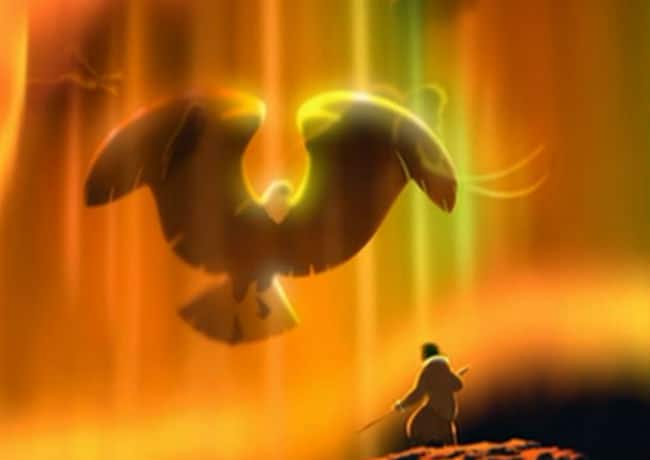
Photo: Disney
The transformation scene is set in the Aura Borealis and ended up being a beautiful scene. It was originally going to be a horrifying thing that would show Kenai’s emotional state, but the team wanted to show that it was a positive thing for him. They also wanted to portray it as a grand and spiritual moment in the story, and the new sequence really shows that I think. It might be worth the watch, just for that scene. And the backgrounds.
PLOT
Brother Bear reminds me a lot of Lilo & Stitch, but where Lilo & Stitch had a focus on the relationship between sisters, Brother Bear focuses on the relationship between brothers. And when it comes to traumatic deaths, Brother Bear reminds us that Disney is not above killing off characters we love.
Which was the last Disney Animated Feature that killed off a character that we knew and cared about? Maybe the parents and the father gorilla in Tarzan? Before that, there were only almost-deaths or deaths of unnamed characters and villain. I don’t think I’ve been so sad about a Disney death since The Lion King killed Mufasa! Even though we only knew Sitka for a short time, and he does come back later in spirit form, his death is a major driving force of the story and affects the whole thing.
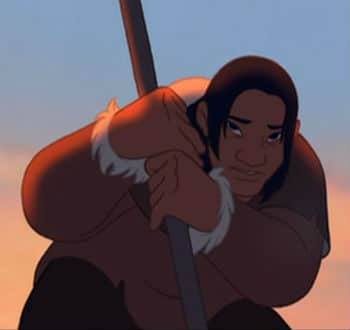
Photo: Disney
Brother Bear follows Kenai, a young boy who is preparing for the ceremony that will reveal his totem and guide him to manhood. Kenai and his brothers, Sitka and Denahi, live and interact like brothers do, fighting and arguing (but still loving each other).
When Kenai is given the totem of the Bear of Love, he is confused and upset (plus, his brother Denahi teases him before Kenai asks his other brother, Sitka, for advice). However, before the ceremony, Kenai didn’t tie up a basket of fish correctly, and during the ceremony, a bear got into them. Denahi is furious that all their hard work is wasted because of Kenai, and Kenai angrily goes after the bear.
The bear isn’t going to let Kenai bully her, however, and his brothers arrive in just time to save his life. In the fight, however, Sitka sacrifices his life to save his brothers. When Kenai wants to kill the bear out of revenge, Denahi and Kenai argue. Kenai, consumed with revenge and hate, goes after the bear, while Denahi going after him to talk some sense into him (because Kenai is his brother and he loves him).
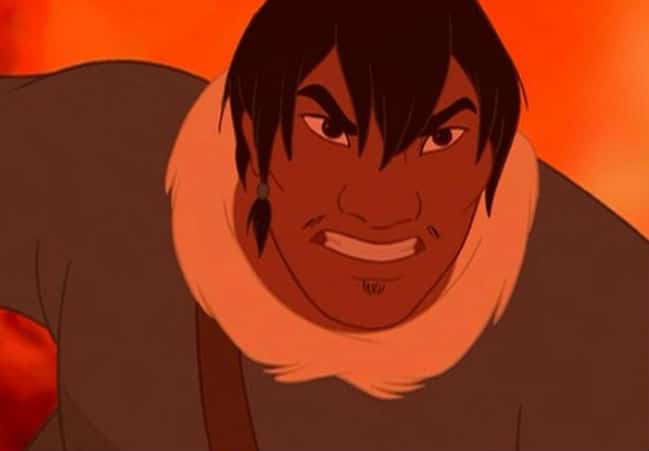
Photo: Disney
Kenai finds the bear and kills her (!). This leads to the arrival of the Spirits, including Sitka, who transforms his little brother into a bear. When Denahi arrives and finds a bear and Kenai’s ripped clothing, he believes his brother has been killed. This turn of events leads to Kenai traveling to convince Sitka’s spirit to change him back, and Denahi trying to kill Kenai-bear to get revenge for his brother Kenai’s death.
While traveling, Kenai meets a young bear named Koda who has been separated from his mother. The two of them travel to the salmon run and the mountain Kenai is searching for, although Kenai is reluctant to travel with someone else. On the trip, Kenai begins to learn about love, bears, brotherhood, and himself. Of course, as Kenai is traveling with Koda on a journey of self-discovery, his brother is hunting him down.
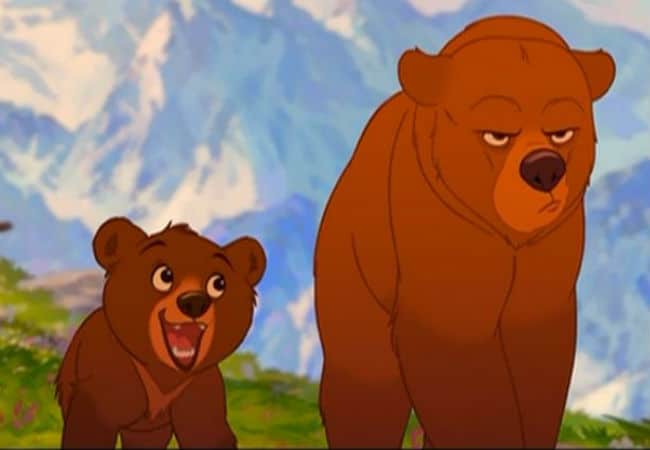
Photo: Disney
Of course, the story isn’t just about Kenai and his human brothers; Koda and Kenai are tied together in ways that they cannot imagine. Will Kenai become human again? Where is Koda’s mother? And will Kenai learn to let his actions be guided by love, and therefore become a man?
SOURCE MATERIAL
I was listening to the “Making Of” feature and learned that after The Lion King was such a hit, then CEO Michael Eisner asked if there were anything other animal stories in the works. He suggested that, perhaps, they make an animal film set in North America, maybe with bears? Director Aaron Blaise mentioned that he liked drawing bears, and the seed for Brother Bear was planted.
As they started to think of their story, the team was inspired by a variety of Native American myths and legends, particularly the transformation stories, and in the “Making Of” feature, they say that they researched these stories extensively when making Brother Bear.
The transformation stories struck a particular chord in the team because the characters were transformed into something else to learn important lessons. They particularly loved the bear transformation stories. As the directing team put it, the idea is that bears hibernates every year and are reborn again in the spring, making them an ideal way for someone to be reborn into a new life.
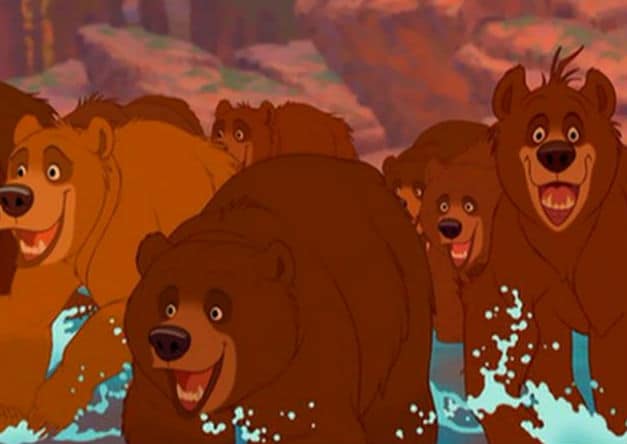
Photo: Disney
Brother Bear is an original story that came out of the Studio, and the team wanted to make their own story that was based, in some ways, on Native American myth. I did some looking around and couldn’t find any sources that suggested that Brother Bear was offensive to anyone, unlike Pocahontas, which my research showed as being highly polarizing. Sorry, I need to let that go.
The story also appealed to the team because they saw it as a universal story; every culture has a story about a transformation. They also point out that all Disney movies are about transformations in some ways, either metaphorically or literally. This just happens to be one of the literal transformation stories.
Originally, the story didn’t have Koda; Kenai met up with an older bear named Grizz, who he looked up to as an older brother. The Directing team loved the character of Grizz, but kept being told that he wasn’t quite “lovable” enough; the story was switched to include a younger brother for Kenai instead. I can’t imagine the story without Koda, so I’m glad that the team made that change.
A major part of the story is the relationships between the brothers, and the team was very intentional about making sure that these relationships were realistic, both between Kenai and Koda and Kenai, Denahi, and Sitka. The animators also studied Inuit clothing, tools, and general facial structures, to make these aspects as realistic as possible.
The 2000’s
In 2003, the United States began to plan to invade Iraq and the Department of Homeland Security began operations. Also that year, the United States and the United Kingdom began air strikes on military targets in Baghdad, before invading Iraq with land forces. In the same year, Saddam Hussein was captured in Tikrit, while an earthquake in northern Algeria killed 2,200 people. Lance Armstrong won his fifth Tour De France and Do Not Call List began to give people a way to limit the amount of time they spent talking to/avoiding telemarketers.
This was the year that Keiko, the whale from Free Willy, died, and the year that Apple launched a little project that they called iTunes. Bird flu was becoming more of a concern, the first cloned horse was born in Italy, the Human Genome Project was finished, and the Space Shuttle Columbia disintegrated, killing all seven astronauts on board.
There was a lot happening in 2003, and the increased globalization due to increased access to the internet meant that people were more in touch with what was happening at that exact moment than before. It was terrifying and exciting and wonderful, all at the same time.
To me, Brother Bear is the kind of movie that was made to remind us to hold on to the people you love because they’re part of you. It can also be seen as a way of reminding us that we really don’t know what’s going on in the heart of another person. Sometimes, we do, but it’s important to conduct ourselves with love and compassion. And there is the added idea of trying to see things through the eyes of others, walking in another person’s shoes.
LESSONS LEARNED
One lesson that I think I can take away from Brother Bear is the importance of forgiveness. Kenai has to forgive bears and ultimately himself, for what happened to Sitka. The moose had to forgive each other as well, for hurting each other.
Kenai also learned the importance of love in everyday life and the bond between brothers (which can be translated to the bond between siblings, though I never tried to spit on my younger siblings. Must be a guy thing?). This love between siblings, though, is shown really well. Like the siblings in the movie, only I can make fun of my siblings, and I would die to save them. This bond really comes across in Brother Bear, and that was great to see.
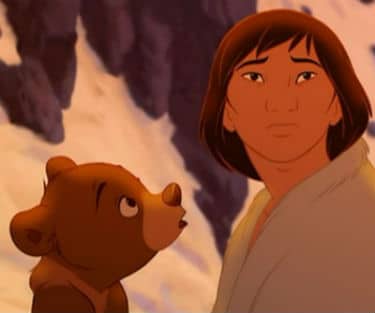
Photo: Disney
Joaquin Phoenix, the voice of Kenai, said that he sees the major lesson in Brother Bear being that when you have to make choices in life if you look at these through the lens of love and compassion, you’re more likely to make the right choices.
Additionally, there is the lesson of looking through the eyes of another person. You can’t know what someone else is going through unless you are willing to walk for a while in their shoes and see what they see.
Another lesson that I saw was that it’s not what’s on the outside, but what’s on the inside that makes you an adult. Learning, growing, and taking responsibility for your actions that make you an adult.
The final lesson that I saw was that you need to take responsibility for your actions. Kenai has to learn to take responsibility for his actions before he can take his place as an adult, so there is definitely some similarity with Simba’s character here.
DOES IT HOLD UP?
Honestly, I love this movie. I laugh, I cry, and I feel emotionally invested in the lives of these characters. The animation is stunning, and I read somewhere that if Brother Bear had been made between five and ten years earlier, it would have been a success. I can definitely see that; while Treasure Planet was made too early, Brother Bear was made too late. This is one of those movies that is gorgeous, fun, and heart-warming all at the same time. If you haven’t seen Brother Bear and are looking for a movie that will make you laugh and cry, check out Brother Bear (it’s available to stream on Netflix).
For next week: Home on the Range and Chicken Little
If you enjoyed this post and the others in the Revisiting Disney series, and have found yourself wishing that you could find them all in one convenient and bound book with eight extra essays, there is an option for you! Check out A Journey Through Disney: My Look Back Through Disney Canon, now available on Amazon as both a Kindle book ($4.99) and a paperback ($11.99).
OTHER SOURCES:
https://thewaltdisneycompany.com/about-disney/disney-history
http://www.imdb.com
http://studioservices.go.com/disneystudios/history.html
http://www.thepeoplehistory.com
Bailey, Adrian. Walt Disney’s World of Fantasy. Everest House Publishers. New York, New York. 1982.
Finch, Christopher. The Art of Walt Disney: From Mickey Mouse to the Magic Kingdom. Harry N. Abrams, Inc. New York, New York. 1975.
Johnston, Ollie and Frank Thomas. The Disney Villain. Hyperion. New York, New York. 1993.
Thomas, Bob. Disney’s Art of Animation From Mickey Mouse to Hercules. Hyperion. New York, New York. 1992.
ARE YOU A ROMANCE FAN? FOLLOW THE SILVER PETTICOAT REVIEW:
 Our romance-themed entertainment site is on a mission to help you find the best period dramas, romance movies, TV shows, and books. Other topics include Jane Austen, Classic Hollywood, TV Couples, Fairy Tales, Romantic Living, Romanticism, and more. We’re damsels not in distress fighting for the all-new optimistic Romantic Revolution. Join us and subscribe. For more information, see our About, Old-Fashioned Romance 101, Modern Romanticism 101, and Romantic Living 101.
Our romance-themed entertainment site is on a mission to help you find the best period dramas, romance movies, TV shows, and books. Other topics include Jane Austen, Classic Hollywood, TV Couples, Fairy Tales, Romantic Living, Romanticism, and more. We’re damsels not in distress fighting for the all-new optimistic Romantic Revolution. Join us and subscribe. For more information, see our About, Old-Fashioned Romance 101, Modern Romanticism 101, and Romantic Living 101.

Comments are closed.